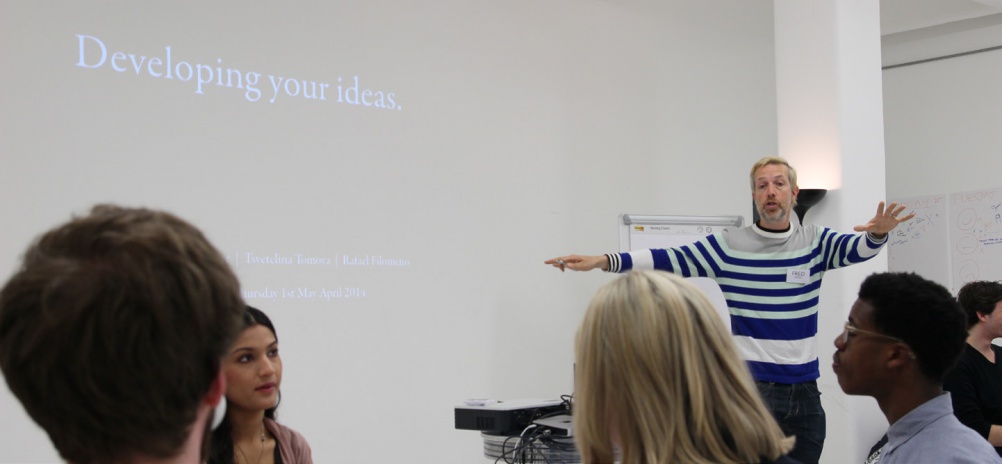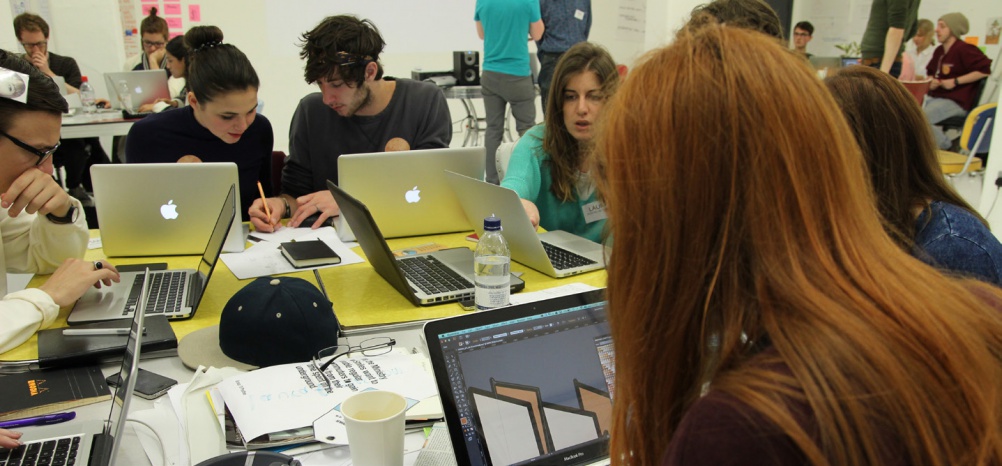“We need to show design students what happens in the real world” – Fred Deakin
University of of Arts London Professor Fred Deakin tells us how his Collabology education initiative is giving students a taste of the professional design world.

“It’s very common for design graduates to enter the workplace without any real experience of the timescales involved, how self-starting they need to be, or experience of collaborating with people with very different skillsets”, says Fred Deakin, professor for interactive digital arts at University of Arts London.
“It’s always been this way”, he adds, “It’s the way education has worked for a long time. But following the digital paradigm shift that has taken place over the past ten years it has become even more important and urgent that graduates have those skills.”
Deakin joined UAL in 2014 as one of nine new cross-university heads. Previously he had co-run consultancy Airside for 14 years, until its closure in 2014, and operated as one half of band Lemon Jelly.
One of the initiatives Deakin has led at UAL is the Collabology project, which aims to promote the kind of collaborative and real-world skills he says many graduates are lacking.
Collabology is a two-week workshop which sees students work together in groups to tackle briefs based around creating “positive change”, using digital collaborative tools. They are mentored through the process by a number of practising designers, including former Airside partner Nat Hunter, Gethin Lewis of Hellicar & Lewis and Andy Huntington, formerly of Berg.
The pilot Collabology scheme launched last year at Mother, and this year’s cohort are currently ensconsed at the Makerversity premises in London’s Somerset House. The students on-site are joined in a digital link-up with other students from Falmouth School of Art and Manchester School of Art.

Deakin says the aim of the project is all about giving students a taste of real life. He says: “The reason we run it as such an intense process is that this is exactly what happens in the real world. When I was running Airside we would get phoned up on Monday morning and the client would say: ‘Oh, we’ve got this project, can you get back to us tomorrow?” I don’t think students really get that that is the speed of things.”
He adds: “Anyone who’s been out in the industry knows that what we’re doing here isn’t particularly extreme, but the students don’t know that and that can be a bit of a shock.
“But then there’s something that happens when they all get together and commit to a project – they feel the power. It’s the same force I remember from running a studio. Somehow this isn’t something that traditional education finds it easy to give to undergraduates as a tangible experience.”
With this year’s digital tie-ups with Manchester and Falmouth, Deakin says he is exploring potential to develop the concept in different ways, but the key thing, he says, is that it benefits both students and the design industry as a whole.
Describing his work as “an undercover educational guerrilla cell at UAL”, Deakin says he hopes the influence of Collabollogy and other projects can spread throughout education and industry.
Deakin says: “I think UAL was very perceptive in that they commissioned me from industry rather than someone from academia and then let me experiment and liaise with industry. If I can be a bridge between students and the design industry then that would be a job done as far as I’m concerned.”
He adds: “There is a big shift in traditional education at the moment – because of fees and the wider economy. There is a growth in new small-scale initiatives and I think that the design community is increasingly seeing how they could own a piece of this and help to train the graduates that they need.”





I think this is exactly what design education needs. Right now it is critical that young designers get a job in a studio/company that has a strong mentoring culture, otherwise they face a steep learning curve on their own or suffer that typical catch 22 of graduate designers – can’t get a job no experience, can’t get experience without a job.
Very true, I recently graduated from an Advertising Design course but felt I was more of a Graphic Designer. I began working at a small creative agency and had to learn a lot of things in my spare time (e.g. Getting artwork ready for print, crop marks, bleed etc), things that I should have learnt in University.
And if they knew the real world. Do you think they would still have the same passion. I remember doing some ideas for a brochure. 8 pages, this clever design. It ended up being a folded A4 full of T&Cs and zero excitiment. Ahh insurance leaflets
This is the very thing that education is desperately missing. Having recently graduated from a Graphic Design course, I am now working at a large Digital Agency. I had collaborated with developers in my personal work although there was not ever an opportunity to do this on my course. I now work very closely with UX and Developers to produce the best possible solution. There needs to be more collaboration between courses and sharing briefs, enabling students to actually realise their designs. Students can learn a lot each other!
At the top universities, students are taught to think big and this is fine if you take a certain path into a leading agency but a high percentage of designers end up in studios, not necessarily in major cities, that require a different appreciation of the process, good housekeeping (file management) and a appreciation for all types of business sectors. Time pressures are a big part of this too but with graduates it is massively about them being managed by a senior who knows exactly how to use the graduates time. The onus is of the senior to make sure they are managing the teams time, being harsh if needed. They are the ones that should know when focus is being wasted at the wrong times. Juniors can be used as scapegoats. If they are managed well they will learn over time.